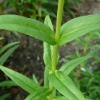Features
Bell shaped, violet flowers with white throats hang off the tall stems of this elegant penstemon. Mid green leaves grow up the length of the stems.
What to use it for
Perfect for cottage style beds and borders.
How to look after it
Will need support in exposed areas to prevent the long stems from bending. In cold areas mulch well in autumn to provide winter protection.
To be on the safe side, you might want to take cuttings each summer in case the parent plant doesn’t survive the winter cold (see propagation information below).
How to prune it
Deadhead regularly to prolong flowering. Cut back to ground level in early spring.
How to propagate it
Semi-ripe stem tip cuttings can be taken in late summer or early autumn. Alternatively seeds can be collected in late summer/autumn and sown in early spring at 15°C, although seeds from cultivars such as ‘Alice Hindley’ may not come true from seed. Penstemons can be hybridised quite easily.
Common problems
May be susceptible to attacks by slugs, snails, two-spotted spider mites and chrysanthemum eelworms (also known as leaf and bud eelworms). Not usually affected by diseases.
Other useful information
This cultivar was developed by the John Forbes (Hawick) nursery in 1931. It has been given the RHS Award of Garden Merit.
The genus name Penstemon, sometimes also spelt as Pentstemon, is thought to refer to ‘five stamens’.







